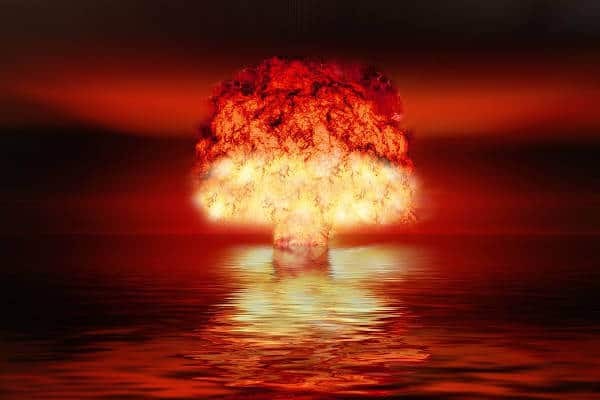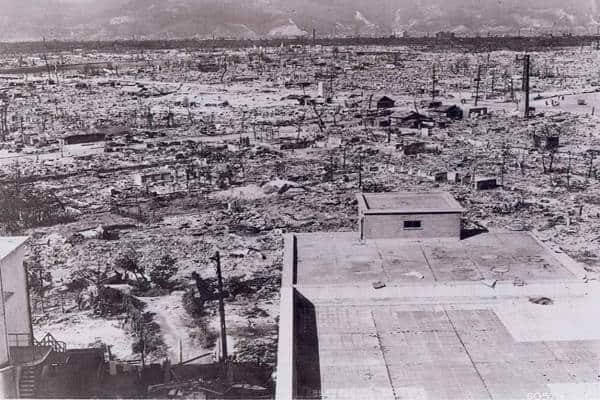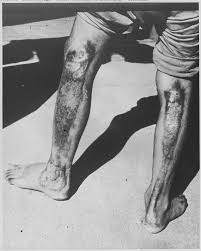What Is A Nuclear Bomb? Nuclear weapons are devastating instruments of mass destruction, unleashing immense power through nuclear reactions. At WHAT.EDU.VN, we aim to provide clear, accessible explanations to complex topics, offering insights and solutions for your learning needs. Explore the mechanics, history, and impact of these weapons, gaining a comprehensive understanding of the risks they pose and the science behind their destructive force. Learn about atomic bombs, hydrogen bombs, nuclear fission, and nuclear fusion.
1. Exploring Nuclear Bombs: An Overview
A nuclear bomb is a weapon that derives its destructive force from nuclear reactions, either fission (splitting of atoms) or a combination of fission and fusion (combining of atoms). Both types of reactions release vast quantities of energy from relatively small amounts of matter. The first nuclear weapons were developed during World War II, leading to unprecedented levels of devastation and prompting ongoing debates about their use and control.
1.1. Understanding Fission and Fusion
1.1.1. Nuclear Fission
Nuclear fission involves splitting the nucleus of a heavy atom, such as uranium or plutonium, into two smaller nuclei. This process releases energy because the mass of the resulting fragments is slightly less than the mass of the original nucleus. The difference in mass is converted into energy according to Einstein’s famous equation, E=mc². This energy manifests as kinetic energy of the fission fragments and emitted neutrons, as well as electromagnetic radiation.
1.1.2. Nuclear Fusion
Nuclear fusion involves combining two light nuclei, such as hydrogen isotopes (deuterium and tritium), to form a heavier nucleus, like helium. Fusion also releases energy because the mass of the resulting nucleus is less than the combined mass of the original nuclei. Fusion reactions require extremely high temperatures and pressures, such as those found in the core of the Sun, to overcome the electrostatic repulsion between the positively charged nuclei.
1.2. Key Components of a Nuclear Bomb
A nuclear bomb typically consists of several key components:
- Nuclear Material: The fissile or fusible material, such as uranium-235, plutonium-239, deuterium, or tritium, that undergoes the nuclear reaction.
- Detonator: A device that initiates the nuclear reaction, typically through conventional explosives that compress the nuclear material.
- Reflector: A material surrounding the nuclear core that reflects neutrons back into the core, increasing the efficiency of the nuclear reaction.
- Tamper: A dense material surrounding the reflector that helps to contain the explosion and further increase the efficiency of the reaction.
- Casing: The outer shell of the bomb, which protects the internal components and provides structural integrity.
2. The Science Behind Nuclear Explosions
The immense destructive power of nuclear bombs stems from the rapid release of energy during nuclear reactions. This energy is released in several forms:
- Blast Wave: A powerful shockwave that travels outward from the point of detonation, causing widespread destruction.
- Thermal Radiation: Intense heat that can ignite fires and cause severe burns over a large area.
- Ionizing Radiation: High-energy particles and electromagnetic waves that can damage living cells and cause radiation sickness and long-term health effects.
- Electromagnetic Pulse (EMP): A burst of electromagnetic energy that can disrupt or damage electronic equipment over a wide area.
- Fallout: Radioactive particles that are carried into the atmosphere and then fall back to Earth, contaminating the environment and posing a long-term health hazard.
2.1. Chain Reactions in Fission Bombs
Fission bombs rely on a self-sustaining chain reaction. When a neutron strikes a fissile nucleus, it causes the nucleus to split and release additional neutrons. If enough fissile material is present (a critical mass), these neutrons can trigger additional fission events, leading to an exponential increase in the number of fissions and a rapid release of energy.
2.2. Thermonuclear Reactions in Fusion Bombs
Fusion bombs, also known as hydrogen bombs or thermonuclear weapons, use a fission reaction to create the high temperatures and pressures necessary to initiate a fusion reaction. A fission bomb, called the primary stage, is detonated to compress and heat a fusion fuel, such as lithium deuteride. The fusion reaction releases even more energy than the fission reaction, making fusion bombs far more powerful than fission bombs.
2.3. Factors Affecting the Size of a Nuclear Explosion
Several factors can affect the size and intensity of a nuclear explosion:
- Yield: The amount of energy released in the explosion, typically measured in kilotons (kt) or megatons (Mt) of TNT equivalent.
- Altitude of Detonation: The height above the ground at which the bomb is detonated. An airburst, detonated at a certain altitude, maximizes the blast radius, while a ground burst creates more fallout.
- Weather Conditions: Wind, precipitation, and temperature inversions can affect the distribution of fallout and the spread of the blast wave.
- Terrain: The topography of the area can influence the direction and intensity of the blast wave and the spread of thermal radiation.
3. The History of Nuclear Bombs: From Conception to Deployment
The development of nuclear bombs was one of the most transformative and controversial scientific endeavors of the 20th century.
3.1. The Manhattan Project
The Manhattan Project was a top-secret research and development undertaking during World War II that produced the first nuclear weapons. Initiated in 1942, the project brought together leading scientists, engineers, and military personnel from the United States, the United Kingdom, and Canada. The project’s main goal was to develop an atomic bomb before Nazi Germany.
3.2. Key Figures in the Development of Nuclear Bombs
Several key figures played crucial roles in the Manhattan Project:
- J. Robert Oppenheimer: The scientific director of the Manhattan Project, responsible for overseeing the design and construction of the atomic bombs.
- Enrico Fermi: An Italian-American physicist who led the team that created the first self-sustaining nuclear chain reaction.
- Leo Szilard: A Hungarian-American physicist who conceived the idea of a nuclear chain reaction and urged the U.S. government to develop atomic weapons.
- Leslie Groves: The military director of the Manhattan Project, responsible for managing the project’s vast resources and personnel.
3.3. The First Nuclear Tests
The first successful test of a nuclear weapon, code-named “Trinity,” took place on July 16, 1945, at the Alamogordo Bombing Range in New Mexico. The test demonstrated the feasibility of the atomic bomb and paved the way for its use in war.
3.4. The Use of Nuclear Bombs in World War II
In August 1945, the United States dropped two atomic bombs on the Japanese cities of Hiroshima and Nagasaki. These bombings resulted in the deaths of hundreds of thousands of civilians and led to Japan’s surrender, effectively ending World War II.
3.4.1. Hiroshima
3.4.1.1. The “Little Boy” Bomb
The bomb dropped on Hiroshima, codenamed “Little Boy”, was a uranium-235 fission bomb. It detonated on August 6, 1945, at approximately 8:15 AM local time.
3.4.1.2. Devastation and Casualties
The explosion instantly killed an estimated 70,000 to 80,000 people. Tens of thousands more died later from burns, radiation sickness, and other injuries. The city was almost completely destroyed.
3.4.2. Nagasaki
3.4.2.1. The “Fat Man” Bomb
The bomb dropped on Nagasaki, codenamed “Fat Man”, was a plutonium-239 implosion-type fission bomb. It detonated on August 9, 1945, at approximately 11:02 AM local time.
3.4.2.2. Devastation and Casualties
The explosion instantly killed an estimated 40,000 to 75,000 people. As in Hiroshima, many more died later from the effects of the blast and radiation. The city suffered extensive damage.
3.5. The Cold War and Nuclear Proliferation
Following World War II, the United States and the Soviet Union engaged in a decades-long Cold War, characterized by intense ideological rivalry and a massive arms race. Both countries developed and stockpiled vast arsenals of nuclear weapons, leading to a constant threat of nuclear war.
3.6. Current Nuclear Arsenals and Treaties
Today, several countries possess nuclear weapons, including the United States, Russia, China, France, the United Kingdom, Pakistan, India, Israel, and North Korea. International treaties, such as the Nuclear Non-Proliferation Treaty (NPT), aim to prevent the spread of nuclear weapons and promote disarmament. However, the threat of nuclear proliferation remains a significant concern.
4. The Effects of a Nuclear Explosion: Immediate and Long-Term Impacts
The effects of a nuclear explosion are devastating and far-reaching, causing immediate destruction and long-term health and environmental consequences.
4.1. Immediate Effects
- Blast: The powerful shockwave can flatten buildings, uproot trees, and cause widespread destruction for miles around the point of detonation.
- Thermal Radiation: The intense heat can ignite fires, melt materials, and cause severe burns to exposed skin.
- Initial Nuclear Radiation: High-energy particles and electromagnetic waves can damage living cells, causing radiation sickness and death.
- Electromagnetic Pulse (EMP): A burst of electromagnetic energy can disrupt or damage electronic equipment, potentially crippling communication networks and infrastructure.
4.2. Long-Term Effects
- Fallout: Radioactive particles can contaminate the environment, posing a long-term health hazard to humans and animals. Exposure to fallout can increase the risk of cancer, birth defects, and other health problems.
- Environmental Damage: Nuclear explosions can cause widespread environmental damage, including deforestation, soil contamination, and water pollution.
- Climate Change: A large-scale nuclear war could inject massive amounts of smoke and soot into the atmosphere, blocking sunlight and causing a period of global cooling known as “nuclear winter.” This could have catastrophic effects on agriculture and ecosystems.
- Social and Economic Disruption: A nuclear attack could disrupt social and economic systems, leading to widespread panic, displacement, and shortages of food, water, and medical care.
4.3. The Psychological Impact of Nuclear War
The threat of nuclear war can have a profound psychological impact on individuals and societies. Fear, anxiety, and despair can lead to mental health problems and social unrest.
5. Types of Nuclear Bombs: A Detailed Look
Nuclear bombs come in various forms, each designed for specific purposes and yielding different levels of destructive power.
5.1. Atomic Bombs (Fission Bombs)
Atomic bombs, also known as fission bombs, use nuclear fission to release energy. They typically use uranium-235 or plutonium-239 as the fissile material. When a neutron strikes a fissile nucleus, it causes the nucleus to split and release additional neutrons, triggering a self-sustaining chain reaction.
5.2. Hydrogen Bombs (Thermonuclear Bombs)
Hydrogen bombs, also known as thermonuclear bombs, use a combination of fission and fusion to release energy. They consist of a fission primary stage and a fusion secondary stage. The fission reaction in the primary stage creates the high temperatures and pressures necessary to initiate the fusion reaction in the secondary stage.
5.3. Neutron Bombs
Neutron bombs are a type of thermonuclear weapon designed to produce a large amount of neutron radiation. They are intended to kill enemy soldiers while minimizing damage to buildings and infrastructure.
5.4. Enhanced Radiation Weapons
Enhanced radiation weapons, also known as reduced blast weapons, are designed to produce a smaller blast and more radiation than traditional nuclear weapons. They are intended to be used against hardened targets, such as bunkers and command centers.
6. Nuclear Strategy and Deterrence: A Complex Equation
Nuclear strategy and deterrence are complex concepts that have shaped international relations for decades.
6.1. Mutual Assured Destruction (MAD)
Mutual Assured Destruction (MAD) is a doctrine of military strategy and national security policy in which a full-scale use of nuclear weapons by two or more opposing sides would cause the complete annihilation of both the attacker and the defender. Under the doctrine of MAD, each side has enough nuclear weaponry to destroy the other side.
6.2. Minimum Deterrence
Minimum deterrence is a nuclear strategy that calls for maintaining a relatively small arsenal of nuclear weapons to deter attack by threatening retaliation against an aggressor’s most valued targets.
6.3. Nuclear Disarmament
Nuclear disarmament is the process of reducing or eliminating nuclear weapons. It is a long-standing goal of many international organizations and governments.
6.4. Nuclear Proliferation
Nuclear proliferation is the spread of nuclear weapons and nuclear weapons technology to countries that do not already possess them. It is a major concern for international security.
7. The Future of Nuclear Weapons: Challenges and Opportunities
The future of nuclear weapons is uncertain. Several challenges and opportunities will shape the future of nuclear weapons in the coming years.
7.1. Technological Advances
Technological advances, such as hypersonic missiles and cyber warfare, could challenge the effectiveness of existing nuclear deterrence strategies.
7.2. Geopolitical Tensions
Rising geopolitical tensions, such as those between the United States and China, could lead to a renewed arms race.
7.3. Arms Control Treaties
Arms control treaties, such as the New START treaty between the United States and Russia, could help to limit the spread of nuclear weapons.
7.4. Public Opinion
Public opinion could play a role in shaping government policies on nuclear weapons.
8. Ethical Considerations: The Morality of Nuclear Weapons
The use of nuclear weapons raises profound ethical questions.
8.1. Just War Theory
Just War Theory is a set of principles that attempt to determine when the use of force is morally justifiable.
8.2. The Principle of Proportionality
The principle of proportionality holds that the use of force must be proportionate to the harm being prevented.
8.3. The Principle of Discrimination
The principle of discrimination holds that military actions should be directed only at legitimate military targets, and not at civilians.
8.4. The Responsibility to Protect (R2P)
The Responsibility to Protect (R2P) is a global political commitment endorsed by all member states of the United Nations in 2005 to prevent genocide, war crimes, ethnic cleansing and crimes against humanity.
9. Nuclear Energy vs. Nuclear Weapons: Understanding the Difference
It’s important to distinguish between nuclear energy, which is used for peaceful purposes like generating electricity, and nuclear weapons, which are designed for destruction. While both involve nuclear reactions, their applications and implications are vastly different.
9.1. Peaceful Uses of Nuclear Energy
- Electricity Generation: Nuclear power plants use nuclear fission to generate heat, which is then used to produce steam and drive turbines to generate electricity.
- Medical Isotopes: Radioactive isotopes are used in medical imaging, cancer treatment, and other diagnostic and therapeutic procedures.
- Industrial Applications: Radioactive materials are used in a variety of industrial applications, such as gauging thickness, sterilizing equipment, and tracing materials.
- Research: Nuclear research is conducted in a variety of fields, including physics, chemistry, biology, and materials science.
9.2. The Dual-Use Dilemma
The dual-use dilemma refers to the fact that many nuclear technologies and materials can be used for both peaceful and military purposes. This makes it difficult to prevent the proliferation of nuclear weapons.
10. Frequently Asked Questions About Nuclear Bombs
Here are some frequently asked questions about nuclear bombs, along with concise and informative answers:
| Question | Answer |
|---|---|
| What is the difference between an atomic bomb and a hydrogen bomb? | An atomic bomb (fission bomb) splits atoms, while a hydrogen bomb (thermonuclear bomb) combines atoms, releasing far greater energy. |
| How does a nuclear bomb work? | It uses nuclear fission or fusion reactions to create an explosion, releasing immense energy as heat, blast, and radiation. |
| What are the immediate effects of a nuclear explosion? | Immediate effects include a massive blast wave, intense thermal radiation, and ionizing radiation, causing widespread destruction and casualties. |
| What are the long-term effects of a nuclear explosion? | Long-term effects include radioactive fallout, environmental damage, increased cancer risk, and potential for climate change. |
| Which countries possess nuclear weapons? | The United States, Russia, China, France, the United Kingdom, Pakistan, India, Israel, and North Korea. |
| What is the purpose of nuclear deterrence? | Nuclear deterrence is the idea that possessing nuclear weapons discourages other countries from attacking with their own nuclear weapons. |
| What is the Nuclear Non-Proliferation Treaty (NPT)? | The NPT is an international treaty aimed at preventing the spread of nuclear weapons and promoting disarmament. |
| What is Mutual Assured Destruction (MAD)? | MAD is a doctrine where a full-scale nuclear exchange would result in the annihilation of both attacker and defender, deterring either side from initiating such an attack. |
| Can nuclear war cause a “nuclear winter”? | A large-scale nuclear war could inject massive amounts of smoke and soot into the atmosphere, blocking sunlight and causing a period of global cooling known as “nuclear winter.” |
| What can I do to learn more about nuclear weapons and disarmament efforts? | Stay informed through reputable news sources, support organizations working for nuclear disarmament, and advocate for responsible policies with your elected officials. |



11. Conclusion: Seeking Understanding and Promoting Peace
Understanding what a nuclear bomb is, how it works, and the devastating consequences of its use is crucial for informed citizenship and responsible decision-making. By learning about the history, science, and ethical considerations surrounding nuclear weapons, we can work together to promote peace and prevent future catastrophes. At WHAT.EDU.VN, we are committed to providing accessible, reliable information to empower individuals with the knowledge they need to address complex global challenges.
Do you have more questions about nuclear weapons or other complex topics? Visit WHAT.EDU.VN today and ask your question for free! Our community of experts is ready to provide you with clear, accurate, and helpful answers. Don’t let your curiosity go unanswered. Join us at 888 Question City Plaza, Seattle, WA 98101, United States, or contact us via WhatsApp at +1 (206) 555-7890. Let what.edu.vn be your go-to resource for all your questions.
Join us as we campaign against Trident, Britain’s nuclear weapons and for the ultimate goal of a nuclear weapons-free world.